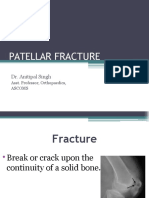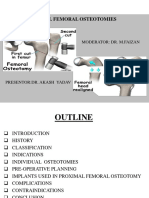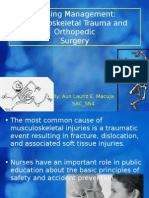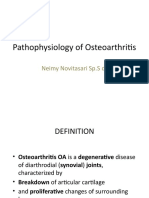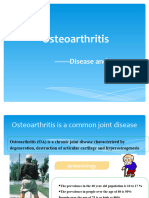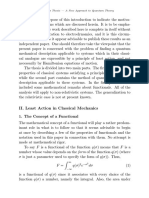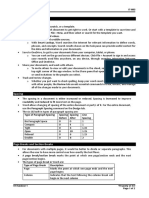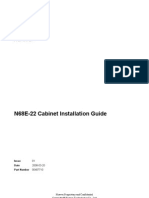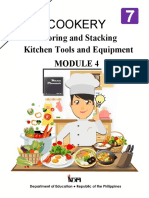0 ratings0% found this document useful (0 votes)
12 viewsClinical Mentoring: Joint Problem Management
Clinical Mentoring: Joint Problem Management
Uploaded by
Amha ViethreeThis document discusses the diagnosis and treatment of joint problems such as osteoarthritis. It describes how to diagnose joint issues through patient history, physical examination, imaging tests, and blood/fluid analysis. Treatment options covered include medications, injections, physical therapy, surgery such as realignment osteotomy and joint replacement, and management of post-surgical complications. Specific conditions like osteoarthritis, ankle sprains, and their treatments are explored in detail with images.
Copyright:
© All Rights Reserved
Available Formats
Download as PPTX, PDF, TXT or read online from Scribd
Clinical Mentoring: Joint Problem Management
Clinical Mentoring: Joint Problem Management
Uploaded by
Amha Viethree0 ratings0% found this document useful (0 votes)
12 views36 pagesThis document discusses the diagnosis and treatment of joint problems such as osteoarthritis. It describes how to diagnose joint issues through patient history, physical examination, imaging tests, and blood/fluid analysis. Treatment options covered include medications, injections, physical therapy, surgery such as realignment osteotomy and joint replacement, and management of post-surgical complications. Specific conditions like osteoarthritis, ankle sprains, and their treatments are explored in detail with images.
Original Title
Clinical Mentoring
Copyright
© © All Rights Reserved
Available Formats
PPTX, PDF, TXT or read online from Scribd
Share this document
Did you find this document useful?
Is this content inappropriate?
This document discusses the diagnosis and treatment of joint problems such as osteoarthritis. It describes how to diagnose joint issues through patient history, physical examination, imaging tests, and blood/fluid analysis. Treatment options covered include medications, injections, physical therapy, surgery such as realignment osteotomy and joint replacement, and management of post-surgical complications. Specific conditions like osteoarthritis, ankle sprains, and their treatments are explored in detail with images.
Copyright:
© All Rights Reserved
Available Formats
Download as PPTX, PDF, TXT or read online from Scribd
Download as pptx, pdf, or txt
0 ratings0% found this document useful (0 votes)
12 views36 pagesClinical Mentoring: Joint Problem Management
Clinical Mentoring: Joint Problem Management
Uploaded by
Amha ViethreeThis document discusses the diagnosis and treatment of joint problems such as osteoarthritis. It describes how to diagnose joint issues through patient history, physical examination, imaging tests, and blood/fluid analysis. Treatment options covered include medications, injections, physical therapy, surgery such as realignment osteotomy and joint replacement, and management of post-surgical complications. Specific conditions like osteoarthritis, ankle sprains, and their treatments are explored in detail with images.
Copyright:
© All Rights Reserved
Available Formats
Download as PPTX, PDF, TXT or read online from Scribd
Download as pptx, pdf, or txt
You are on page 1of 36
CLINICAL MENTORING
JOINT PROBLEM MANAGEMENT
dr. Muh. Ardi Munir, M.Kes., Sp.OT., FICS., M.H
ORTHOPAEDICS PROBLEMS
HOW TO DIAGNOSIS JOINT PROBLEM
HISTORY
• PAIN
• DEFORMITY
• STIFFNESS
• SWELLING
• INSTABILITY
• WEAKNESS
• LOSS OF FUNCTION
PHYSICAL EXAMINATION
• LOOK COLOUR CHANGES, CHARACTERISTIC POSTURE
• FEEL CHANGE OF TEMPERATURE, EXCESSIVE JOINT
EFFUSION
• MOVE STIFFNES (ABSENT, LIMITED, OR PARTIAL),
UNSTABLE MOVEMENT, JOINT LAXITY, JOINT DEFORMITY
(CONTRACTURE, MUSCLE IMBALANCE, DISLOCATION,
JOINT DESTRUCTION)
DIAGNOSTIC IMAGING
• PLAIN X-RAYS
• ARTHROGRAPHY
• COMPUTED TOMOGRAPHY
• MAGNETIC RESONANCE IMAGING
• DIAGNOSTIC ULTRASOUND
• RADIONUCLIDE IMAGING
BLOOD TEST AND SYNOVIAL FLUID ANALISYS
OSTEOARTHRITIS
X-RAY KNEE NORMAL VS OA
KELLGREN-LAWRENCE GRADING SCALE
MEDICATION - FIRST LINE
• NSAIDs, including COX-2 inhibitors, are mainstays in the non
operative treatment of arthritis.
• Meta-analysis shows these medications to be slightly more
effective than a placebo in the short term.
• NSAIDs have a high rate of side effects, including
gastrointestinal bleeding.
• Acetaminophen is widely used for pain relief.
MEDICATION - SECOND LINE
• The use of nutraceuticals, such as glucosamine and chondroitin
sulfate, is controversial, with a recent study showing no benefit
• Intra-articular injection:
- With corticosteroids, decreases pain for short periods
- With hyaluronic acid, may have a small effect on knee pain
• Opioid pain medicine may be used for severe pain in patients
who are not operative candidates.
INTRA-ARTICULAR INJECTIONS
SURGERY
Realignment osteotomy:
• The joint surfaces are repositioned by cutting the bone and
changing the axis of weight bearing.
• Purpose: Allows the healthiest articular cartilage to bear the
most weight
• May be combined with ligament or meniscal repair
REALIGNMENT OSTEOTOMY:
SURGERY
Joint Replacement - Arthroplasty:
• The arthritic joint surfaces are removed, and a new joint surface
is implanted.
• The bearing surface is typically metal on high-density
polyethylene.
• Examples are total hip arthroplasty, total knee arthroplasty, and
total shoulder arthroplasty.
OA SHOULDER JOINT TSR
OA HIP JOINT THR
OA KNEE JOINT TKR
SPECIAL THERAPY - PHYSICAL THERAPY
• Patients should begin a program to preserve muscle strength
and ROM and to avoid contractures.
• Heavy-impact activity (such as running, contact sports, and
heavy work) exacerbates symptoms.
• A cane used in the opposite hand substantially reduces the
forces across the hip joint and will relieve discomfort and
improve gait.
SPECIAL THERAPY - COMPLEMENTARY AND
ALTERNATIVE THERAPIES
• Acupuncture may provide pain relief for knee arthritis in the
short term.
• Many herbal medicines are used for the treatment of
osteoarthritis.
• Evidence to support their use is limited.
PROGNOSIS
• Osteoarthritis progressively worsens with time.
• No cure exists.
• Modern methods of joint replacement provide excellent function
and pain relief.
COMPLICATIONS
• Progressive arthritis leads to worsening deformity and stiffness.
• In the lower extremity, patients may stop walking and rely on
wheelchairs
• In the upper extremity, prevents activities and leads to lack of function
• Treatment also may lead to complications.
• The side effects of NSAIDs include gastritis and gastrointestinal
bleeding.
• Surgical intervention may lead to infection, DVT, or failure of the
replacement mechanical joint.
ANKLE SPRAIN
HISTORY
Mechanism of injury causing sprain:
• Inversion in plantarflexion:
ATFL injury
• Inversion in dorsiflexion:
CFL injury
TREATMENT
• RICE protocol
• Partial weightbearing with crutches in the acute phase (first 3-7
days), which is advanced as tolerated to full weightbearing
• Stirrup ankle brace to facilitate early ambulation
• Gentle active ROM as tolerated is advised.
• Activity modification (rest, sports restriction) until strength
returns
RICE PROTOCOL
RICE
MEDICATION (DRUGS)
First Line
• NSAIDs and analgesics can be used for severe sprains, but they
usually are not necessary.
SURGERY
• Surgical repair of acute ankle ligament tear is rarely indicated
• Primary repair of ATFL and CFL
• Surgery may be indicated for patients with recurrent instability.
• In such patients, repair of the lateral ankle ligaments or
reconstruction with part of the peroneus brevis tendon usually is
successful.
PHYSICAL THERAPY
• ROM
• Strengthening exercises
• Proprioceptive retraining
ANY QUESTION
You might also like
- Collected Male Dr. Svasti Report Status: Final: Name Lab No. P 159709569 Mr. Dushyant HoodaDocument2 pagesCollected Male Dr. Svasti Report Status: Final: Name Lab No. P 159709569 Mr. Dushyant Hoodadushyant33% (3)
- Analysis of Profile Map - PQWT Water DetectorDocument76 pagesAnalysis of Profile Map - PQWT Water DetectorFrancisco Hernán Berrios Valenzuela100% (1)
- 87 Slides Fundamentals in Orthopedic Surgery 2019Document88 pages87 Slides Fundamentals in Orthopedic Surgery 2019Mark Samuel Tanchoco100% (1)
- Femoral Neck FractureDocument21 pagesFemoral Neck FractureSugar Capule - ManuelNo ratings yet
- Ultrasound and clinically guided Injection techniques on the musculoskeletal systemFrom EverandUltrasound and clinically guided Injection techniques on the musculoskeletal systemNo ratings yet
- Patellar FractureDocument43 pagesPatellar FractureAkash KoulNo ratings yet
- Patellar Fracture: Karla Suzatte M. Dasargo DDC PT - InternDocument43 pagesPatellar Fracture: Karla Suzatte M. Dasargo DDC PT - Internk135dNo ratings yet
- ARTHROPLASTYDocument39 pagesARTHROPLASTYArathyNo ratings yet
- 1-22 Osteoporosis & Hip PainDocument79 pages1-22 Osteoporosis & Hip PaintarikeopsNo ratings yet
- Osteotomies Jarthrodesis JDocument41 pagesOsteotomies Jarthrodesis Jdesire kbpNo ratings yet
- Management of Ankle OsteoarthritisDocument14 pagesManagement of Ankle Osteoarthritisgaraka jayasuriyaNo ratings yet
- Lower Limb Trauma: Cast Application For Common FracturesDocument58 pagesLower Limb Trauma: Cast Application For Common FracturesdrusmanjamilhcmdNo ratings yet
- Total Knee ReplacementDocument49 pagesTotal Knee Replacementefancoolhand09No ratings yet
- Total Knee Replacement (TKR) : Dr. Aamer NaeemDocument41 pagesTotal Knee Replacement (TKR) : Dr. Aamer NaeemfaizasaleemsameNo ratings yet
- Osteoarthritis: Dr. C. C. VisserDocument85 pagesOsteoarthritis: Dr. C. C. VisserAhmad Fathira FitraNo ratings yet
- Osteo-Arthritis: Kalabyraveshwara Swamy Ayurvedic Medical Colledge, Hospital& Research Centre, BangaloreDocument25 pagesOsteo-Arthritis: Kalabyraveshwara Swamy Ayurvedic Medical Colledge, Hospital& Research Centre, BangaloreTAJNo ratings yet
- Materi D'secret Dr. Tanti Ajoe Kesoema, SP.K.F.R., M.S. (K), M.Si - Med (FIN)Document38 pagesMateri D'secret Dr. Tanti Ajoe Kesoema, SP.K.F.R., M.S. (K), M.Si - Med (FIN)dina rialdiNo ratings yet
- Arthritis CmeDocument13 pagesArthritis CmeBigabwa BernardNo ratings yet
- Musculoskeletal TraumaDocument54 pagesMusculoskeletal TraumaAbo AmgadNo ratings yet
- Oa RaDocument24 pagesOa RaRehab NaeemNo ratings yet
- Proximal Femoral NewDocument34 pagesProximal Femoral NewHimanshu HemantNo ratings yet
- Fractures HFHDocument74 pagesFractures HFHEmmanuel Papa AcquahNo ratings yet
- As-B13 Acute Joint DislocationDocument74 pagesAs-B13 Acute Joint DislocationeimonthetkhineNo ratings yet
- Osteoarthritis: Dr. Angelo Smith M.D WHPLDocument51 pagesOsteoarthritis: Dr. Angelo Smith M.D WHPLChuks LeviNo ratings yet
- Osteoarthritis: Prepared by Dr/Mohammed AlshehariDocument17 pagesOsteoarthritis: Prepared by Dr/Mohammed AlsheharimosaNo ratings yet
- 2 2-ArthritidesDocument76 pages2 2-ArthritidesAvinash KaushikNo ratings yet
- Groin InjuriesDocument48 pagesGroin Injuriesayesharajput5110No ratings yet
- Ankle Instability 6feb2024Document80 pagesAnkle Instability 6feb20246775494030No ratings yet
- The Hip: Therapeutic Exercise 2 Lino Linford BangayanDocument91 pagesThe Hip: Therapeutic Exercise 2 Lino Linford BangayanLino Linford Yu Bangayan100% (1)
- Charcot Joint & Methods of ArthrodesisDocument59 pagesCharcot Joint & Methods of ArthrodesisNajeeb BsoulNo ratings yet
- Osteo Arthit IsDocument19 pagesOsteo Arthit IsShaa ShawalishaNo ratings yet
- Nursing Management: Musculoskeletal Trauma and Orthopedic SurgeryDocument25 pagesNursing Management: Musculoskeletal Trauma and Orthopedic SurgeryDeannahTampusNo ratings yet
- Lecture 7 Femoral Diapisis and Distal FDocument16 pagesLecture 7 Femoral Diapisis and Distal FQueen SofiaNo ratings yet
- Nur Rachmat Lubis: Divisi Orthopaedi Dept Bedah FK UNSRI/ RS Dr. M. Hoesin PalembangDocument38 pagesNur Rachmat Lubis: Divisi Orthopaedi Dept Bedah FK UNSRI/ RS Dr. M. Hoesin Palembangsoleha09la solehaNo ratings yet
- 68 DISEASES 2nd Semsester 3rd Year 1 PDFDocument117 pages68 DISEASES 2nd Semsester 3rd Year 1 PDFJimlord GarciaNo ratings yet
- Traction NursingDocument75 pagesTraction NursingSujith KuttanNo ratings yet
- Osteoarthritis 191016103144Document49 pagesOsteoarthritis 191016103144dr.abouzaid098No ratings yet
- Minimally Invasive & Endoscopic Spine SurgeryDocument45 pagesMinimally Invasive & Endoscopic Spine SurgeryBabu RamakrishnanNo ratings yet
- OsteoarthritisDocument40 pagesOsteoarthritiskylieverNo ratings yet
- The Principles of Intra-Articular Fracture Care: Joseph Schatzker M.D., B.SC., (Med.), F.R.C.S. (C)Document31 pagesThe Principles of Intra-Articular Fracture Care: Joseph Schatzker M.D., B.SC., (Med.), F.R.C.S. (C)baoNo ratings yet
- Knee OsteoarthritisDocument22 pagesKnee OsteoarthritisHK FreeNo ratings yet
- Pathophysiology of OsteoarthritisDocument41 pagesPathophysiology of OsteoarthritisghaziaNo ratings yet
- OsteoarthritisDocument45 pagesOsteoarthritisMar ClrNo ratings yet
- Osteoarthritis Malaysian CPG 2013Document25 pagesOsteoarthritis Malaysian CPG 2013aideeh3110100% (1)
- Caring For Patients With Musculoskeletal DisordersDocument16 pagesCaring For Patients With Musculoskeletal DisorderszebeneNo ratings yet
- Degenerative Disorders of JointsDocument25 pagesDegenerative Disorders of JointsayuNo ratings yet
- S-Malunion - Principals and ManagementDocument45 pagesS-Malunion - Principals and ManagementshahnazroeentanmailNo ratings yet
- Running Injury: Hui-Ting Lin, PT, PHDDocument36 pagesRunning Injury: Hui-Ting Lin, PT, PHDMandy NgNo ratings yet
- KULIAH TRAUMA MUSKULOSKELETAL dr. TaufanDocument62 pagesKULIAH TRAUMA MUSKULOSKELETAL dr. TaufansweetmasaldyNo ratings yet
- 43-44 - Muscuskeletal DisordersDocument39 pages43-44 - Muscuskeletal DisordersTaif SalimNo ratings yet
- Orthopaedics Med Surgical NursingDocument109 pagesOrthopaedics Med Surgical Nursingmaurinej2000No ratings yet
- Fracture Treatment AssessmentDocument15 pagesFracture Treatment Assessmentamylsonbq6045No ratings yet
- Arthroplasty of Shoulder - MKKPPTXDocument54 pagesArthroplasty of Shoulder - MKKPPTXMis StromNo ratings yet
- 1 - Biomechanics - Gait AnalysisDocument48 pages1 - Biomechanics - Gait Analysisandirahmawan99No ratings yet
- Osteoarthritis: - Typically Affects The Fingers, Spine, Hips andDocument36 pagesOsteoarthritis: - Typically Affects The Fingers, Spine, Hips andsuyatmiNo ratings yet
- Oa KneeDocument17 pagesOa KneeChitra ChauhanNo ratings yet
- Musculoskeletal SystemDocument44 pagesMusculoskeletal Systemayesharajput5110No ratings yet
- Sprains and StrainsDocument23 pagesSprains and StrainsokaciaNo ratings yet
- Orthopaedic Emergencies AndreDocument49 pagesOrthopaedic Emergencies AndreLusi MunawarohNo ratings yet
- The KneeDocument57 pagesThe Kneeniamh traceyNo ratings yet
- Reduction, Relocation and Splinting in Emergency Room (RASER)From EverandReduction, Relocation and Splinting in Emergency Room (RASER)No ratings yet
- Facing Up The Past - and The Present Land Rights in GabonDocument160 pagesFacing Up The Past - and The Present Land Rights in GabonzebracatNo ratings yet
- Feynman Thesis FunctionalDocument3 pagesFeynman Thesis FunctionalVinayak RajNo ratings yet
- Quiz #6Document7 pagesQuiz #6Michael MerlinNo ratings yet
- Nonlinear RegressionDocument21 pagesNonlinear RegressionTesfayeNo ratings yet
- Dr. Goutam Sen: Indian Institute of Technology (IIT) Kharagpur West Bengal, IndiaDocument39 pagesDr. Goutam Sen: Indian Institute of Technology (IIT) Kharagpur West Bengal, IndiaSiddharthPutuvelyNo ratings yet
- Crane Duty Chart 21.02.2019Document9 pagesCrane Duty Chart 21.02.2019naren1202No ratings yet
- BNP Paribas Uk-Student-Housing-Market-Update - Compressed-1Document2 pagesBNP Paribas Uk-Student-Housing-Market-Update - Compressed-1hamza3iqbalNo ratings yet
- People To Acknowledge Before You Pay Money in Satta MatkaDocument13 pagesPeople To Acknowledge Before You Pay Money in Satta MatkamanipurmatkaNo ratings yet
- Autobiography of A YogiDocument3 pagesAutobiography of A YoginimueqNo ratings yet
- Contracts For Differences Info CFDDocument2 pagesContracts For Differences Info CFDJoel FrankNo ratings yet
- Expository Writing Course Outline - Sept 2021 - HECDocument34 pagesExpository Writing Course Outline - Sept 2021 - HECrafiyaNo ratings yet
- Report Welding PoliDocument15 pagesReport Welding PoliSyahzlan IskandarNo ratings yet
- General Criteria For Design Steel StructureDocument12 pagesGeneral Criteria For Design Steel StructureSurat WaritNo ratings yet
- Zima Digital Assets - Emergency Motion 4/1/20Document51 pagesZima Digital Assets - Emergency Motion 4/1/20Michael Haley100% (1)
- Word Features: Type of Paragraph Spacing Spacing Before Spacing After Line SpacingDocument2 pagesWord Features: Type of Paragraph Spacing Spacing Before Spacing After Line SpacingRonibeMalinginNo ratings yet
- Characteristics of LDCsDocument22 pagesCharacteristics of LDCstinsaeres100% (2)
- Practical Research 2: Grade 12 Learning Module First QuarterDocument19 pagesPractical Research 2: Grade 12 Learning Module First QuarterItsClarenceNo ratings yet
- Mquay ChilledDocument84 pagesMquay ChilledRidwan Pramudya100% (1)
- N68E 22 Cabinet Installation Guide (V200R010 - 01)Document131 pagesN68E 22 Cabinet Installation Guide (V200R010 - 01)mahaumaNo ratings yet
- Learner'S Activity Sheets (Las) : ObjectiveDocument5 pagesLearner'S Activity Sheets (Las) : ObjectiveYnna Lyn ManaloNo ratings yet
- Wisdom Literature and ProverbsDocument11 pagesWisdom Literature and Proverbsroe100% (1)
- TLE7 HE COOKERY Mod4 Storing Stacking Kitchen Tools and Equipment v5Document31 pagesTLE7 HE COOKERY Mod4 Storing Stacking Kitchen Tools and Equipment v5Cristina Rhain WinterNo ratings yet
- Passed 135-08-19 Kalinga Comparing Numbers Using Less Than, Gretaer Than and Equal - Activity Sheets For Mathematics 1-1Document27 pagesPassed 135-08-19 Kalinga Comparing Numbers Using Less Than, Gretaer Than and Equal - Activity Sheets For Mathematics 1-1Juliene Leones ClaroNo ratings yet
- Week 1Document11 pagesWeek 1Fawad Ali Sher KhanNo ratings yet
- Switch Ports MerakiDocument10 pagesSwitch Ports MerakiCarlos Torres MoranNo ratings yet
- Décima Práctica Dirigida de Biología Ciclo: Semianual - San Marcos 2002Document7 pagesDécima Práctica Dirigida de Biología Ciclo: Semianual - San Marcos 2002nixonmaikolNo ratings yet
- Flight InternationalDocument60 pagesFlight InternationalPPMNo ratings yet
- The Reading Matrix Vol. 7, No. 1, April 2007Document21 pagesThe Reading Matrix Vol. 7, No. 1, April 2007Lidya_Rismaya_6886No ratings yet





